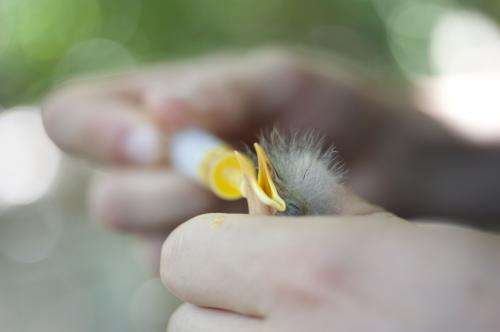Published today by the Zoological Society of London (ZSL) and University of Cambridge, the study reveals that male hihi birds develop more colourful and attractive breeding feathers if they receive a nest diet rich in carotenoids – natural pigments found mainly in fruit and vegetables.
Scientists looked at the effects of newborn nutrition on male plumage in the rare New Zealand hihi (Notiomystis concta) over the course of a year. The paper was published in Proceedings of The Royal Society B.
ZSL and University of Cambridge PhD student Leila Walker says: "We first hand-fed baby hihi birds either a carotenoid supplement - natural pigments used to colour yellow, orange and red - or a more complete dietary supplement. Then we looked at the effect this had on male breeding feather colour once those chicks had grown and moulted into their adult plumage."
All nestlings initially develop female-like plumage and fledge at around one month old. Youngsters then moult their body feathers at about four months old, during which time the males obtain their breeding features. Colourful plumage is an important factor in a bird's breeding success as it demonstrates the strong health of a bird to females.
ZSL Research Fellow Dr. John Ewen says: "We saw that nestlings receiving more carotenoids were brighter as adults. This was a combined result of the carotenoid-rich dietary supplement they received, and the carotenoids they obtained as part of a natural diet fed to them by their parents."
Research on hihi has highlighted how sensitive an individual's life is to experiences faced as a nestling. Scientists are now gaining an idea of the information content of different plumage ornaments used in breeding. The next steps will be to manipulate these signals in adult birds to further test the effects on mating success.
Almost all wild hihi populations require conservation support in terms of food supplementation. ZSL will continue to work on narrowing down on a diet that produces the most, and best quality, offspring to help rebuild high numbers of this most brightly coloured of New Zealand birds.
Journal information: Proceedings of the Royal Society B
Provided by Zoological Society of London



















